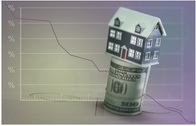Advertisement
S&P/Case-Shiller Home Price Index: U.S. Home Prices Dip Even Further

Data through October 2010, released by Standard & Poor’s for its S&P/Case-Shiller Home Price Indices, the leading measure of U.S. home prices, show a deceleration in the annual growth rates in 18 of the 20 Metropolitan Statistical Areas (MSAs) and the 10- and 20-City Composites in October compared to what was reported for September 2010. The 10-City Composite was up only 0.2 percent and the 20-City Composite fell 0.8 percent from their levels in October 2009. Home prices decreased in all 20 MSAs and both Composites in October from their September levels.
In October, only the 10-City Composite and four MSAs—Los Angeles, San Diego, San Francisco and Washington D.C.—showed year-over-year gains. While the composite housing prices are still above their spring 2009 lows, six markets—Atlanta; Charlotte, N.C.; Miami, Fla.; Portland, Ore.; Seattle, Wash. and Tampa, Fla.—hit their lowest levels since home prices started to fall in 2006 and 2007, meaning that average home prices in those markets have fallen beyond the recent lows seen in most other markets in the spring of 2009.
The chart above depicts the annual returns of the 10-City and the 20-City Composite Home Price Indices. In October 2010, the 10-City and 20-City Composites recorded annual returns of +0.2 percent and -0.8 percent, respectively. October was the fifth consecutive month where the annual growth rates moderated from their prior month’s pace, confirming a clear deceleration in home price returns. The 10-City Composite posted a +0.2 percent annual growth rate in October, versus the +5.4 percent reported five months prior in May, and the 20-City Composite has now reentered negative territory, down 0.8 percent in October versus its +4.6 percent May print.
“The double-dip is almost here, as six cities set new lows for the period since the 2006 peaks. There is no good news in October’s report. Home prices across the country continue to fall.” said David M. Blitzer, chairman of the Index Committee at Standard & Poor's. “The trends we have seen over the past few months have not changed. The tax incentives are over and the national economy remained lackluster in October, the month covered by these data. Existing homes sales and housing starts have been reported for both October and November, and neither is giving any sense of optimism. On a year-over-year basis, sales are down more than 25 percent and the months’ supply of unsold homes is about 50 percent above where it was during the same months of last year. Housing starts are still hovering near 30-year lows. While delinquency rates might have seen some recent improvement, it is only on a relative basis. They are still well above their historic averages, in both the prime and sub-prime markets.
The chart above shows the index levels for the 10-City and 20-City Composite Indices. As of October 2010, average home prices across the United States are back to the levels where they were in mid 2003. Measured from June-July 2006 through October 2010, the peak-to-current declines for the 10-City Composite and 20-City Composite are -29.7 percent and -29.6 percent, respectively. The improvements from their April 2009 trough are +5.7 percent and +4.4 percent, respectively.
Both the 10-City and 20-City Composites fell by more than one percent in October versus September. The 10-City Composite was down 1.2 percent and the 20-City Composite fell by 1.3 percent. All 20 of the metro areas also declined in October compared to September. Fifteen of the MSAs were down by one percent or more in October, with Atlanta posting the largest decline of 2.9 percent.
An October index level of 68.86 in Detroit indicates that average home prices are more than 30 percent below their January 2000 values. Las Vegas, Cleveland and Atlanta are just about back to their 2000 levels, with October prints of 100.97, 102.20 and 103.30, respectively. On a relative basis, Los Angeles, New York and Washington, D.C. have fared best, retaining the most of their mid-2000 price appreciation. Each of these markets is more than 70 percent above their January 2000 levels.
The table below summarizes the results for October 2010. The S&P/Case-Shiller Home Price Indices are revised for the 24 prior months, based on the receipt of additional source data. More than 23 years of history for these data series is available, and can be accessed in full by clicking here.
Since its launch in early 2006, the S&P/Case-Shiller Home Price Indices have published, and the markets have followed and reported on, the non-seasonally adjusted data set used in the headline indices. For analytical purposes, Standard & Poor’s does publish a seasonally adjusted data set covered in the headline indices, as well as for the 17 of 20 markets with tiered price indices and the five condo markets that are tracked. A summary of the monthly changes using the seasonally adjusted (SA) and non-seasonally adjusted (NSA) data can be found in the table below.
About the author





